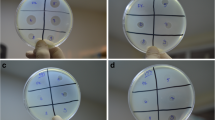Abstract
P. syringae pv. syringae was shown to be the cause of bacterial blight in 40% of field pea crops showing symptoms of bacterial blight during 2005 compared to 47.5% caused by P. syringae pv. pisi and the 12.5% of crops infected by both pathovars. A replicated field experiment conducted in the presence of stubble infected with P. syringae pv. syringae quantified yield losses in commercial cultivars due to this pathovar. Within this study field pea cultivars could be divided into two groups based on resistance or susceptibility to bacterial blight caused by P. syringae pv. syringae. The average yield loss in the resistant cultivars in the presence of infected field pea stubble was 23%, whereas in the susceptible cultivars the yield loss was 75%. In one cultivar a yield loss of 94% was measured. Variability between cultivars and breeding lines in their responses indicates potential for breeders to develop P. syringae pv. syringae resistant cultivars. Studies into the survival of P. syringae pv. syringae on infected field pea stubble showed that the pathogen could not be recovered after 34 weeks.
Similar content being viewed by others
References
Bevan JR, Taylor JD, Crute IR, Hunter PJ, Vivian A (1995) Genetics of specific resistance in pea (Pisum sativum) cultivars to seven races of Pseudomonas syringae pv. pisi. Plant Pathol 44:98–108
Butler LD, Fenwick HS (1970) Austrian winter pea, a new host of Pseudomonas syringae. Plant Dis Report 64:467–471
Clarke R (1990) The incidence of bacterial blight (Pseudomonas syringae pv. pisi) of field peas in Victoria. Plant Protect Q 5:160–161
Fahy PC, Lloyd AB (1983) Pseudomonas: The fluorescent pseudomonads. In: Fahy PC, Persley GJ (eds) Plant Bacterial Diseases. Academic, Sydney, pp 141–188
Friedman M (1937) The use of ranks to avoid the assumption of normality implicit in the analysis of variance. J Am Stat Assoc 32:675–701
Hildebrand D, Schroth M, Sands D (1988) Pseudomonads. In: Schaad N (ed) Laboratory guide for identification of plant pathogenic bacteria. The American Phytopathological Society, St. Paul, pp 60–80
Hirano SS, Upper CD (1990) Population biology and epidemiology of Pseudomonas syringae. Annu Rev Phytopathol 28:155–177
Hollaway GJ, Bretag TW (1995a) The occurrence of Pseudomonas syringae pv. pisi in field pea (Pisum sativum) crops in the Wimmera region of Victoria, Australia. Australas Plant Pathol 24:133–136
Hollaway GJ, Bretag TW (1995b) The occurrence and distribution of races of Pseudomonas syringae pv. pisi in Australia and specificity towards various field pea (Pisum sativum) cultivars. Aust J Exp Agri 35:629–632
Hollaway GJ, Bretag TW (1997) Survival of Pseudomonas syringae pv. pisi in soil and on pea trash and their importance as a source of inoculum for a following pea crop. Aust J Exp Agri 37:369–375
Hollaway GJ, Bretag TW, Price TV (2007) The epidemiology and management of bacterial blight (Pseudomonas syringae pv. pisi) of field pea (Pisum sativum) in Australia: a review. Aust J Agric Res 58:1086–1099
Jindal K, Bhardwaj S (1989) Etiology of bacterial blight of peas caused by Pseudomonas syringae pv. syringae. Plant Dis Res 4:165–166
King EO, Ward MK, Raney DE (1954) Two simple media for the demonstration pyocyanin and fluorescin. J Lab Clin Med 44:301–307
Knott CM (1987) A key for the stages of development of the pea (Pisum sativum). Ann Appl Biol 111:233–244
Kovacs N (1956) Identification of Pseudomonas pyocyanea by the oxidase reaction. Nature 178:703
Lawyer A, Chun W (2001) Foliar diseases caused by bacteria; bacterial blight. In: Kraft JM, Pfleger FL (eds) Compendium of pea diseases and pests. The American Phytopathological Society, St. Paul, pp 22–23
Lelliott RA, Billing E, Hayward AC (1966) A determinative scheme for the fluorescent plant pathogenic pseudomonads. J Appl Bacteriol 29:470–489
Maki LR, Galyan EL, Chang-Chien MM, Caldwell DR (1974) Ice nucleation induced by Pseudomonas syringae. Appl Microbiol 28:456–459
Mazarei M, Kerr A (1990) Distinguishing pathovars of Pseudomonas syringae on peas: nutritional, pathogenicity and serological tests. Plant Pathol 39:278–285
Taylor JD, Dye DW (1972) A survey of the organisms associated with bacterial blight of peas. NZ J Agric Res 15:432–440
Taylor JD, Bevan JR, Crute IR, Reader SL (1989) Genetic relationship between races of Pseudomonas syringae pv. pisi and cultivars of Pisum sativum. Plant Pathol 38:364–375
Wimalajeewa DLS, Nancarrow RJ (1984) Bacterial blights of peas in Victoria. Aust J Exp Agric Anim Husbandry 24:450–452
Acknowledgements
Funding for this project was provided by the Grains Research and Development Corporation (GRDC) and the Victorian Department of Primary Industries. Thanks to Debra Partington for assistance with the statistical analysis and Jade Ellen, Jonathan Bretag, Graham Exell and Dennis Ward for their technical support. Thanks also to Dr. Eric Armstrong (Department of Industry and Investment, Wagga Wagga, New South Wales) and his technical staff for assistance and Dr Trevor Bretag for his critical comments on the manuscript.
Author information
Authors and Affiliations
Corresponding author
Rights and permissions
About this article
Cite this article
Richardson, H.J., Hollaway, G.J. Bacterial blight caused by Pseudomonas syringae pv. syringae shown to be an important disease of field pea in south eastern Australia. Australasian Plant Pathol. 40, 260–268 (2011). https://doi.org/10.1007/s13313-011-0039-9
Received:
Accepted:
Published:
Issue Date:
DOI: https://doi.org/10.1007/s13313-011-0039-9




